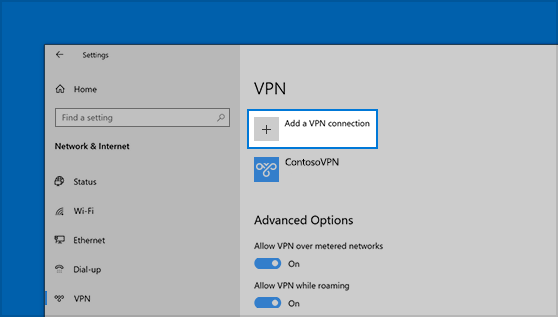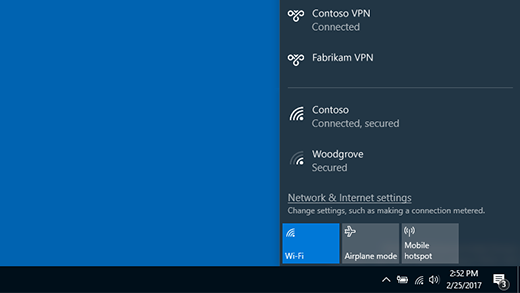How To Connect To Office Network From Home Using Vpn
Whether it's for work or personal use, you can connect to a virtual private network (VPN) on your Windows PC. A VPN connection can help provide a more secure connection and access to your company's network and the internet, for example, when you're working from a coffee shop or similar public place.
Note:
This feature is not available in Windows 11 SE. Learn more
Create a VPN profile
Before you can connect to a VPN, you must have a VPN profile on your PC. You can either create a VPN profile on your own or set up a work account to get a VPN profile from your company.
Before you start:
-
If it's for work, look for VPN settings or a VPN app on your company's intranet site while you're at work, or contact your company's support person.
-
If it's for a VPN service you subscribe to for personal use, visit the Microsoft Store to see if there's an app for that service, then go to the VPN service's website to see if the VPN connection settings to use are listed there.
-
Select theStartbutton, then type settings. SelectSettings>Network & internet >VPN >Add VPN.
-
InAdd a VPN connection, do the following:
-
ForVPN provider, chooseWindows (built-in).
-
In theConnection name box, enter a name you'll recognize (for example, My Personal VPN). This is the VPN connection name you'll look for when connecting.
-
In theServer name or addressbox, enter the address for the VPN server.
-
ForVPN type, choose the type of VPN connection you want to create. You'll need to know which kind of VPN connection your company or VPN service uses.
-
ForType of sign-in info, choose the type of sign-in info (or credentials) to use. This might be a username and password, one-time password, certificate, or a smart card if you're connecting to a VPN for work. Enter your username and password in the respective boxes (if required).
-
-
SelectSave.
-
If you need to edit the VPN connection info or specify additional settings, such as proxy settings, choose the VPN connection and then selectAdvanced options.
Connect to a VPN
When you have a VPN profile, you're ready to connect.
-
In Settings, select Network & internet >VPN.
-
Next to the VPN connection you want to use, select Connect.
-
If you're prompted, enter your username and password or other sign-in info.
When connected, the VPN connection name will displayConnectedunderneath it. To see if you're connected to the VPN while you're doing things on your PC, hover your mouse pointer over the Network icon on the far right of the taskbar, then see if the VPN connection shows.
Tip:You can also connect to a VPN through quick settings and the notification area. To add VPN as a quick setting, select the Network icon on the taskbar, then select Edit quick settings > Add > VPN > Done.
Whether it's for work or personal use, you can connect to a virtual private network (VPN) on your Windows 10 PC. A VPN connection can help provide a more secure connection and access to your company's network and the internet, for example, when you're working from a coffee shop or similar public place.
Create a VPN profile

Before you can connect to a VPN, you must have a VPN profile on your PC. You can either create a VPN profile on your own or set up a work account to get a VPN profile from your company.
Before you start:
-
If it's for work, look for VPN settings or a VPN app on your company's intranet site while you're at work, or contact your company's support person.
-
If it's for a VPN service you subscribe to for personal use, visit the Microsoft Store to see if there's an app for that service, then go to the VPN service's website to see if the VPN connection settings to use are listed there.
-
Select the Start button, then select Settings > Network & Internet > VPN > Add a VPN connection.
-
In Add a VPN connection, do the following:
-
For VPN provider, choose Windows (built-in).
-
In the Connection name box, enter a name you'll recognize (for example, My Personal VPN). This is the VPN connection name you'll look for when connecting.
-
In the Server name or address box, enter the address for the VPN server.
-
For VPN type, choose the type of VPN connection you want to create. You'll need to know which kind of VPN connection your company or VPN service uses.
-
For Type of sign-in info, choose the type of sign-in info (or credentials) to use. This might be a username and password, one-time password, certificate, or a smart card if you're connecting to a VPN for work. Enter your username and password in the respective boxes (if required).
-
-
Select Save.
-
If you need to edit the VPN connection info or specify additional settings, such as proxy settings, choose the VPN connection and then selectAdvanced options.
Connect to a VPN
When you have a VPN profile, you're ready to connect.
-
On the far right of the taskbar, select the Network icon (either or).
-
Select the VPN connection you want to use, then do either of the following depending on what happens when you select the VPN connection:
-
If the Connect button displays under the VPN connection, select Connect.
-
If the VPN section in Settings opens, select the VPN connection there, then select Connect.
-
-
If you're prompted, enter your username and password or other sign-in info.
When connected, the VPN connection name will display Connected underneath it. To see if you're connected to the VPN while you're doing things on your PC, select the Network icon (either or) on the far right of the taskbar, then see if the VPN connection says Connected.

How To Connect To Office Network From Home Using Vpn
Source: https://support.microsoft.com/en-us/windows/connect-to-a-vpn-in-windows-3d29aeb1-f497-f6b7-7633-115722c1009c
Posted by: scottthad1944.blogspot.com

0 Response to "How To Connect To Office Network From Home Using Vpn"
Post a Comment